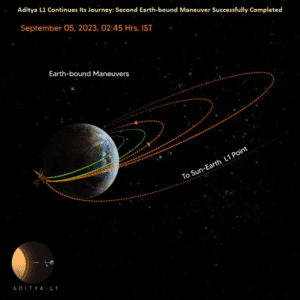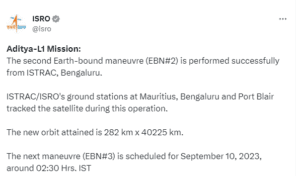The Aditya L1 mission, India’s ambitious endeavor to observe the Sun, has reached a significant milestone with its second successful Earth-bound maneuver. This maneuver brings the satellite one step closer to its mission to study our nearest star, the Sun.

India’s first solar mission, Aditya L1, has successfully performed its second Earth-bound maneuver. The maneuver was carried out on September 5, 2023, and it has put the spacecraft on track to reach its final destination, the Lagrange Point 1 (L1).
Aditya L1, named after the revered Sun God ‘Aditya’ in Hindu mythology, is a critical project by the Indian Space Research Organization (ISRO). The satellite’s primary objective is to closely observe and analyze the Sun’s outermost layer, known as the solar corona, and the impact of solar activities on our planet.

In its latest feat, Aditya L1 executed a precise maneuver to position itself for optimal observations of the Sun. The successful completion of this maneuver demonstrates the expertise and dedication of ISRO’s scientists and engineers.
This crucial step in the mission signifies that Aditya L1 is on the right path to achieve its scientific goals. As it continues its journey through space, the satellite will gather valuable data that will enhance our understanding of the Sun’s behavior and its influence on Earth’s climate and technology.

The L1 point is a gravitationally stable location between the Earth and the Sun. Aditya L1 will be placed in a halo orbit around the L1 point, where it will study the Sun’s atmosphere, solar magnetic storms, and its impact on the Earth’s environment.

The next maneuver for Aditya L1 is scheduled for September 10, 2023. This maneuver will put the spacecraft in the transfer orbit towards the L1 point. Aditya L1 is expected to reach the L1 point in about 125 days.

The successful completion of the second Earth-bound maneuver is a major milestone for the Aditya L1 mission. The spacecraft is now one step closer to its final destination, where it will begin its mission to study the Sun.

The Indian Space Research Organization (ISRO) announced that Aditya L1’s orbit was changed for the second time on September 5. After this maneuver, the solar vehicle is now orbiting the Earth in an elliptical path with dimensions of 282 km x 40,225 km. Aditya will continue to change its orbit repeatedly as part of its journey towards the Sun, with the next orbit change scheduled for September 10.

The VELC payload, in particular, is expected to send around 150,000 images per day after reaching the Lagrange point. Scientists will analyze this data to study solar phenomena, predict solar storms, and better understand the effects of solar weather changes.


With each successful maneuver, Aditya L1 inches closer to unlocking the secrets of the Sun and contributing to scientific advancements in solar research. The ISRO team’s efforts are indeed commendable, as they strive to shed light on the celestial body that sustains life on Earth and has fascinated humanity for millennia.
